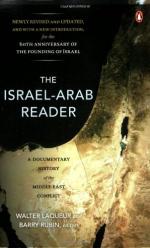
|
| Name: _________________________ | Period: ___________________ |
This test consists of 15 multiple choice questions and 5 short answer questions.
Multiple Choice Questions
1. What did Hassanain Haykal reveal in the high level Arab leaders?
(a) Sense of history.
(b) Shortcoming.
(c) Strength.
(d) Hope.
2. What was the basis of the Palestinian struggle, according to the Popular Front for the Liberation of Palestine?
(a) Racial equality.
(b) Class struggle.
(c) Religion war.
(d) Land war.
3. When was the Manifesto of the United Arab Republic published?
(a) April, 1964
(b) April, 1963.
(c) April, 1966.
(d) April, 1965.
4. Who backed the Arabs, according to Abba Eban?
(a) Syria.
(b) The Soviet Union.
(c) The OPEP.
(d) Germany.
5. Where were many concentration camp survivors living at the time of the report of the Anglo-American Committee?
(a) In relocation camp.
(b) In France.
(c) In Russia.
(d) In the concentration camp.
6. When was the Basle Declaration done?
(a) 1897.
(b) 1896.
(c) 1901.
(d) 1892.
7. Beside Palestine, what other location does the founder of Zionism think would be suitable for a Jewish state?
(a) Canada.
(b) China.
(c) Argentina.
(d) Australia.
8. For what reason did Abba Eban address the United Nations?
(a) Palestinian rights.
(b) Refugee campl.
(c) Egypt.
(d) The Six Day War.
9. What did the Popular Front for the Liberation of Palestine feel the guerrilla movement lack?
(a) Money.
(b) Weapons.
(c) International recognition.
(d) Revolutionary ideology.
10. Why did the Fatah reject the U.N. resolution?
(a) It did not create a country for Palestinians.
(b) It required coexistence between Jews and Arabs.
(c) It left Israel untouched.
(d) It claimed it ignores the rights of the Palestinian people.
11. Who called for the total withdrawal of Israel from the territories occupied during the war in response of U.N. Resolution 242?
(a) The Soviet Union.
(b) The U.S.
(c) Jordan.
(d) The U.K.
12. When did Egyptian armies have Israel's army in retreat?
(a) 1974.
(b) 1976.
(c) 1973.
(d) 1975.
13. To whom did Vladimir Zo'ev Jabotinsky writes?
(a) The League of Nation.
(b) The New York Post.
(c) The Palestine Royal Commission.
(d) The Jewish Concil.
14. When was U.N. Resolution 242 written?
(a) 1970.
(b) 1968.
(c) 1967.
(d) 1969.
15. Who was promoting a Jewish state and founded Zionism?
(a) Joseph Coen.
(b) David Ben Gurion.
(c) Theodor Herzl.
(d) Karl Rosenberg.
Short Answer Questions
1. What organization was charted in 1963?
2. What was Yizhak Rabin's former role?
3. Who defended the right for Arabs to regain their land from Israel?
4. What did the most of the educated and most competent Palestinians do, according to Ahmed Baha Ed-Dine?
5. What was the basis of the Fatah's creation?
|
This section contains 398 words (approx. 2 pages at 300 words per page) |

|




